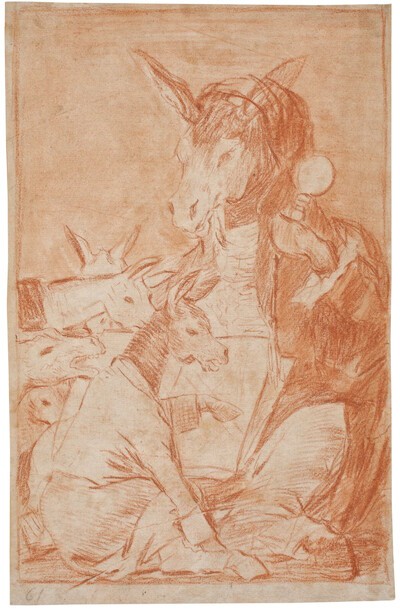- Cronología
- Ca. 1797 - 1799
- Dimensiones
- 218 x 153 mm
- Técnica y soporte
- Aguafuerte, aguatinta bruñida y buril
- Reconocimiento de la autoría de Goya
- Undisputed work
- Titular
- Ailsa Mellon Bruce Collection
- Ficha: realización/revisión
- 13 Dec 2010 / 29 May 2024
- Inventario
- 225
Si sabrá mas el discipulo? (at the bottom)
37. (in the upper right-hand corner)
See Francisco de Goya y Lucientes, Painter.
There are some early printings in which the title is uncorrected, as the word "sabrá" does not have an accent and the question mark does not appear.
In a state proof, the master-assassin's left hoof appears, but Goya decided to remove it in the final version, possibly to humanise him more.
A preparatory drawing for this engraving is in the Prado Museum.
In the centre of the engraving, a donkey is teaching several smaller donkeys to read. The teacher is seated on the ground, wearing a cap that covers his ears and wearing a knotted tie and sleeves with frilly cuffs. Between his paws he holds an open book with four "A's". In one of his hooves he holds a stick with which to impose his discipline if necessary. In front of the book, a pupil is trying to learn the lesson with three other pupils in the background, one of whom seems to be braying to repeat the letters. The animal in the foreground is also dressed in human clothing and raises a paw that rests on the page.
Goya insists in this picture, as an enlightened man, on the importance of education as the foundation for a better society and criticises the lack of training that teachers often had. He uses the figure of the donkey to ridicule some teachers who, because of their training, could never achieve good results.
Edith Helman points out the relationship between this print and the novel by José Francisco de Isla de la Torre y Rojo (Vidanes, León, 1703-Bologna, 1781), History of the Famous Preacher Fray Gerundio de Campazas, alias Zotes. This text tells the story of Gerundio, born in the town of Campazas in León and the son of a wealthy farmer, who attended a school where his own teacher was an ignoramus.
This engraving inaugurates in the series of The Caprices what have come to be known as "asnerías", a compact group of prints which ends in Capricho no. 42, You Who Cannot. They feature the donkey, a figure that forms part of Goya's iconography and which the painter used to refer to stupidity and ignorance. It is likely that Goya was aware of the presence of this animal in the writings of Erasmus of Rotterdam (Rotterdam, 1466-Basel, 1536) or Andrea Alciato (Alzano, Milan, 1492-Pavía, 1550), which may have served as a source of inspiration.
The plate is in poor condition with the aquatint rather weakened (the National Chalcography, no. 208).
-
Goya. Gemälde Zeichnungen. Graphik. TapisserienKunsthalle BaselBasle1953from January 23th to April 12th 1953cat. 227
-
Goya. La década de Los CaprichosMadrid1992organized by Real Academia de Bellas Artes de San Fernando sponsored by Fundación Central Hispano, Madrid, consultant editor Nigel Glendinnig. From October 26th 1992 to January 10th 1993cat. 130
-
GoyaNationalmuseumStockholm1994consultant editors Juan J. Luna and Görel Cavalli-Björkman. From October 7th 1994 to January 8th 1995cat. 63
-
Francisco de GoyaMuseo d'Arte ModernaLugano1996exhibition celebrated from September 22nd to November 17th.cat. 37, p.64
-
Francisco Goya. Sein leben im spiegel der graphik. Fuendetodos 1746-1828 Bordeaux. 1746-1996Galerie KornfeldBern1996from November 21st 1996 to January 1997cat. 43
-
Goya artista de su tiempo y Goya artista únicoThe National Museum of Western ArtTokyo1999from December 1st to July 3th 1999cat. 115
-
Goya e la tradizione italianaFondazione Magnani RoccaMamiano di Traversetolo (Parma)2006consultant editors Fred Licht and Simona Tosini Pizzetti. From September 9th to December 3th 2006cat. 37, p.155
-
Goya. Opera graficaPinacoteca del Castello di San GiorgioLegnano2006exhibition celebrated from December 16th 2006 to April 1st 2007p.33
-
Goya luces y sombrasCaixaForumBarcelona2012consultant editors José Manuel Matilla and Manuela B. Marqués. From March 16th to June 24th 2012cat. 29
-
Goya et la modernitéPinacothèque de ParisParís2013from October 11st 2013 to March 16th 2014cat. 142
-
Goya: Order and disorderMuseum of Fine ArtsBoston2014cat. 53
-
Goya engravings and lithographs, vol. I y II.OxfordBruno Cassirer1964p.109, cat. 72
-
Vie et ouvre de Francisco de GoyaParísOffice du livre1970p.180, cat. 522
-
Goya, la década de los caprichos: dibujos y aguafuertesMadridReal Academia de Bellas Artes de San Fernando1992pp.217-220, cat. 129-131
-
Catálogo de las estampas de Goya en la Biblioteca NacionalMadridMinisterio de Educación y Cultura, Biblioteca Nacional1996p.93, cat. 126
-
El libro de los caprichos: dos siglos de interpretaciones (1799-1999). Catálogo de los dibujos, pruebas de estado, láminas de cobre y estampas de la primera ediciónMadridMuseo Nacional del Prado1999pp.212-215
-
ParísPinacoteca de París2013p. 204
-
Goya: Order & DisorderBostonMuseum of Fine Arts Boston Publications2014p.118
-
Goya. In the Norton Simon MuseumPasadenaNorton Simon Museum2016pp. 42-75

